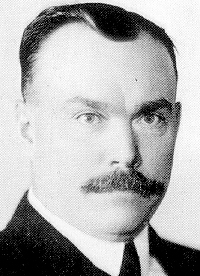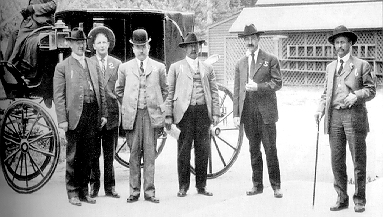Harry Orchard was described in Collier's magazine in 1907 as "the most remarkable witness that has ever appeared in an American court of justice." For several days in June of 1907, Orchard recounted from the stand, in a polite, precise, matter-of-fact, and unhesitating way, a career as a union terrorist, under the direction of the inner circle of the WFM, that resulted in the loss of 17 lives, including that of Governor Frank Steunenberg. Cross-examined for 26 hours about his killings, bigamy, heavy drinking, compulsive gambling and womanizing, Orchard stood up to his grilling in a way that amazed even veteran reporters.
Harry Orchard was born Albert Horsley in 1867, one of eight sons of an Ontario farmer. Educated only through the third grade, Orchard worked his father's farm and took a job in a cheese factory before leaving Canada at age 30 for the northwest United States. By 1899, Orchard had found work in a Burke, Idaho silver mine and joined the WFM. Orchard was among the thousand miner who hijacked a Northern Pacific train on April 29, 1899 and then blew up the Bunker Hill concentrator, killing two men. Orchard was one of the miners who planted the dynamite and lit a fuse. Orchard's career as a paid union terrorist began in 1903 when he blew up the Vindicator mine in Colorado, again killing two men, for a fee of $500. Six months later a bomb planted by Orchard at an Independence, Colorado train depot exploded, killing 13 non-union miners. In his testimony, Orchard also told of other planned killings that for one or another reason did not succeed, all ordered, he claimed by Haywood and Pettibone. Among the unsuccessful efforts were the assassination of the Governor and two Supreme Court justices of Colorado and the president of the Bunker Hill Mining Company. The reason for Orchard life of union terrorism is not entirely clear, but was most likely the result of a combination of factors-- anger at mine operators and scabs, union loyalty, and greed.
Orchard testified that he was hired by Haywood to kill Steunenberg as revenge for the former governor's harsh crackdown on miners in 1899. He said that Haywood asked him to kill Steunenberg after four others had bungled the job. If he killed the man Haywood said had "lived seven years too long," Orchard would be given several hundred dollars and a ranch. Orchard checked into the Saratoga Hotel in Caldwell under the name "Thomas Hogan." He assembled an eight by four inch bomb using ten pounds of dynamite and on December 30, 1905 planted it by Steunenberg's side entrance gate.
On the stand, Orchard's body convulsed with sobs as he described the "unnatural monster I had been." He said that a Bible sent by a missionary society in Chicago convinced him that "I would be forgiven if I truly repented and decided to make a clean breast of it all." Suggestions that a confession might lead to more lenient treatment may also have had something to do with his decision to become state's witness.
In the February, 1906 confession that Orchard gave to Pinkerton detective James McParland, concluded by saying:
I awoke, as it were, from a dream, and realized that I'd been made a tool of, aided and assisted by members of the Executive Board of the Western Federation of Miners....I resolved, as far as in my power, to break up this murderous organization and to protect the community from further assassinations and outrages from this gang."
Orchard, third from left, being transported to prison after his trial
Orchard was tried and convicted in March, 1908 for the killing of Frank Steunenberg. He was sentenced to die in the gallows, but Judge Fremont Wood recommended that his sentence be commuted to life in prison and the Board of Pardons agreed. Orchard remained a trusty of the Idaho State Penitentiary, raising chickens and growing strawberries, until his death in 1954.


